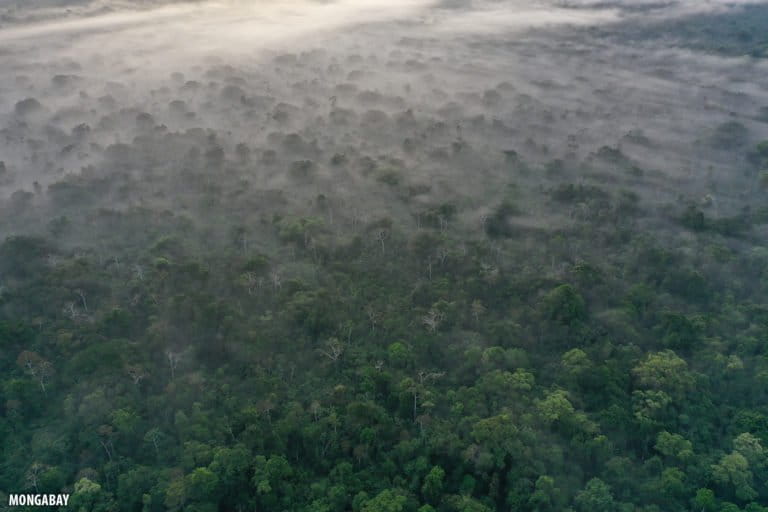This year’s COP28 kicked off in Dubai on Nov. 30 and saw Amazonian countries arriving with a string of environmental triumphs since the last climate summit hosted in Egypt. While…
Kichwa leader Quinto Inuma Alvarado, president the Santa Rosillo de Yanayacu community, was murdered last Wednesday, November 29, in the San Martín region of the Peruvian Amazon. The crime took…
A severe drought across the Amazon Rainforest continues to be felt along the Tapajós River in Brazil’s state of Pará, where locals say it “is the worst one ever.”
Between 15 and 18% of the least-studied areas in the Brazilian Amazon are at high risk of severe climate and land-use changes by 2050, research has shown, meaning we could…
There’s near-universal folklore told throughout Brazil of colorful fish that fall from the clouds during the rains to live in newly formed ponds. These stories arose to explain a hard-to-believe…
One of Brazil’s largest states is ramping up efforts to monitor cattle ranching in the hopes of combatting deforestation and reducing carbon emissions. A new traceability program will keep tabs…
Positive changes President Lula’s speeches at the Climate Conventions 28th Conference of the Parties (COP28) in Dubai contained positive signs for Amazonia and for mitigating climate change. Brazil had the…
Brazil has proposed a new mechanism for conserving the world's tropical rainforests. During a panel at the COP28 climate summit in Dubai, Brazilian Environment Minister Marina Silva and Finance Minister…
The Amazon has long been considered home to Indigenous peoples, dating back thousands of years. They worked the land in ways we are familiar with today. They built ditches, ponds,…
The Sawré Muybu Indigenous Territory is in the final stages of getting state protection, but previous right-wing administrations delayed demarcation.
Germany was among the donor countries that welcomed the revival of the Amazon Fund at the start of the year, seen as an important conservation measure by Brazilian President Luis…
LA CEIBA, Colombia — Nine years ago, Delio de Jesús Suárez Gómez made a pact with wild bees. The arrangement didn’t come easy, given that neither party knew each other…
In 1996, Dutch biologist Marc van Roosmalen first described a small “piggy-like” porcupine near the Madeira River in the Brazilian Amazon. The creature had brown fur, yellow and black quills,…
Global food trader Cargill has announced new commitments to disentangle some of its most controversial agricultural products from deforestation in several South American countries. But some conservation groups say the…
The new model suggests that Amazon plants would reorganize, allocating more energy to their roots at the expense of stems and leaves; consequently, they would have a lower capacity to retain and absorb carbon in a scenario with reduced rainfall.
MRN, a mining company and aluminum producer, denied consultation rights to long-established Amazon riverine communities when it launched a new mine, impacting their way of life, say local people.
Renowned primatologist and conservationist Jane Goodall is bringing her youth program, Roots & Shoots, to the Brazilian Amazon in partnership with Indigenous leaders and tech entrepreneur and conservationist Dax Dasilva.…
Indigenous people and advocates are fighting for the Tanaru Indigenous land to remain an Indigenous territory, but ranchers want to take possession of the plot to turn it into pastures and soy fields.
According to data from Brazil’s National Institute for Space Research (INPE), deforestation in the Brazilian Amazon has declined by 22% for the year ending July 31, 2023. Mongabay’s CEO and…
To all of those who are concerned about climate change and have decided that forest carbon credits are bad, I have a question for you. Have you ever looked closely…
Indigenous forest guardian Paulo Paulino Guajajara was killed in November 2019 in the Brazilian Amazon. Mongabay’s Karla Mendes, who interviewed Paulo nine months before his death, returned to the Arariboia Indigenous Territory in August 2023 to talk with his family and the other guardian who survived the attack, Laércio Guajajara, and shine a light on a case that still hasn’t gone to trial after four years.
In both national and multilateral fora, Bolivia is increasingly showing its reluctance to curb deforestation. President Luis Arce, soon to be entering the penultimate year of his term, has built…
When it comes to dirty money, countries like Switzerland, Panama and Spain’s Canary Islands have earned a reputation as good hiding spots. They’re rife with shell companies and laundered profits.…
Carbonext, which is partially owned by Shell oil company, has been accused of having convinced Indigenous people in the Brazilian Amazon to sign documents containing blank pages and of offering…
Deforestation in Earth's largest rainforest decreased by 22% in the year ending July 31, 2023, according to data released on Thursday by Brazil's National Space Research Institute (INPE). The analysis…
The researchers estimate that 123 childhood deaths during the 2008-19 period are associated with exposure to pesticides from the soy fields, amounting to half the deaths of children under 10 from lymphoblastic leukemia in the region.
It’s been well-documented that local temperatures rise in an area after the forest has been cleared. There’s no canopy to block the sun from hitting the soil directly and no…
In the village of Tarapacá, a group of women are working to strike the perfect balance between using the natural resources of the Amazon rainforest for income and protecting this…
The Amazon - spread over half of South America and filled with thousands of unique species and billions of trees – is being ravaged by global demand for beef, soy…
The Amazon Rainforest is being hit by three kinds of drought at once: an “eastern El Niño,” a “central El Niño” and an “Atlantic dipole.”


































































